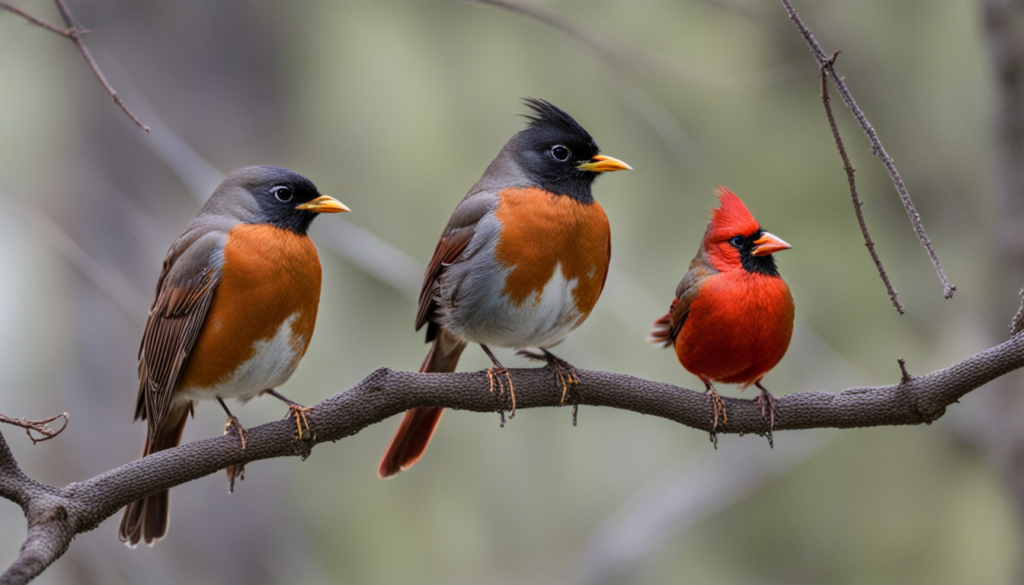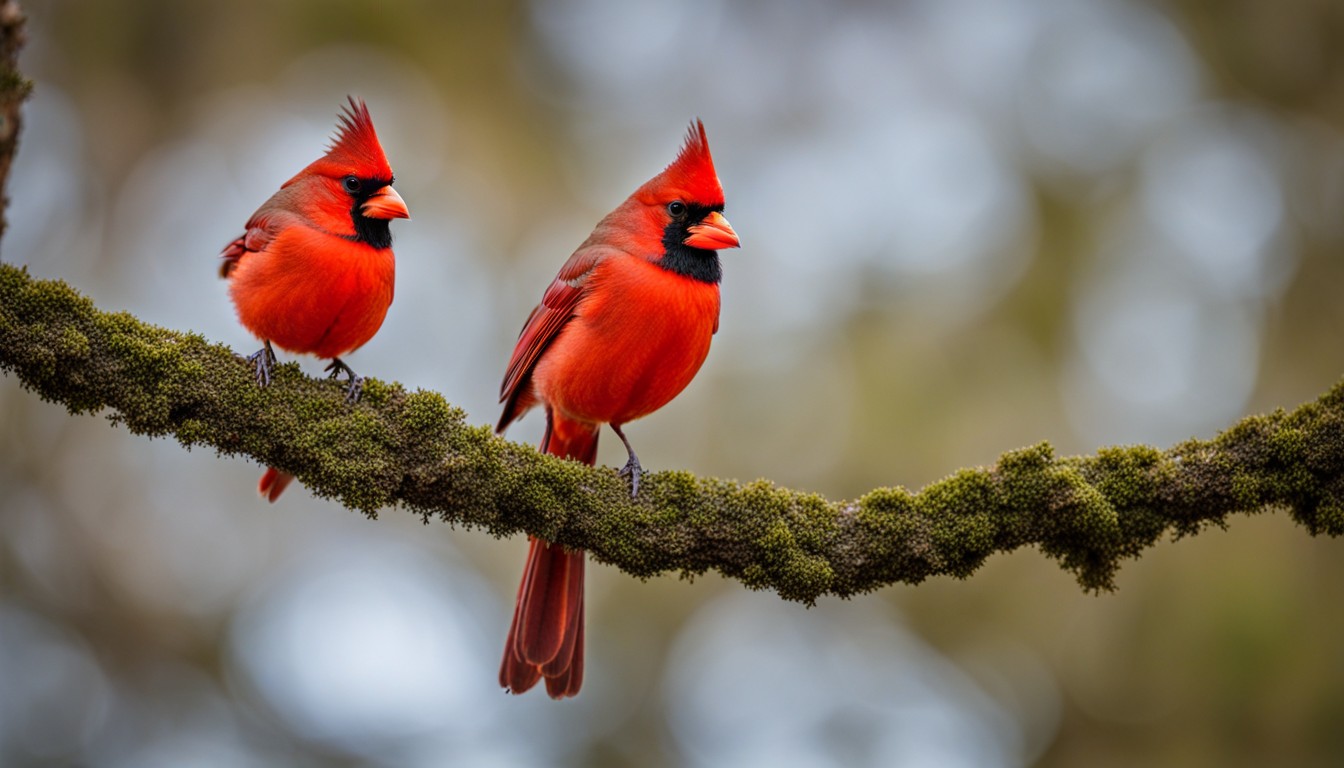Red Robin vs Cardinal: The bright red Northern Cardinal and the rusty orange and black American Robin are two of the most familiar backyard birds in North America. Both species can be found across much of the United States and into Canada.

These birds share some similarities. They are both medium-sized songbirds that frequent backyards, gardens, and woodland edges.
However, there are several key differences between the Northern Cardinal and the American Robin in terms of appearance, size, habitat, diet, behavior, and more.
Key Takeaways:
- Cardinals have bright red plumage, a crest on their head, stubby beaks, and rounded tails. Robins have black heads, gray backs, long yellow beaks, and fan-shaped tails.
- Robins are slightly larger than cardinals.
- Cardinals nest in dense shrubs while robins will nest in a variety of spots.
- Cardinals eat more seeds and fruits while robins favor insects and worms.
- Cardinal songs are loud whistles, robin songs are more complex and melodious.
- Cardinals are more solitary and territorial compared to the communal robins
Red Robin Vs Cardinals
| Characteristics | Red Robin | Cardinal |
|---|---|---|
| Appearance | Black head, gray-brown back, wings & tail with a rust-orange breast and belly | Bright red with a black face mask (males), gray mask and olive-gray plumage with reddish tinge (females) |
| Size | A little larger than cardinals | Smaller than robins |
| Beak | Longer and more pointed, yellow in color | Short, cone-shaped, red in color |
| Crest | No crest | Crest on top of head |
| Habitat and Nesting | Nests in a variety of places, including in a tree or shrub, gutter of a house, on the ground, nesting shelf, or within an overhang | Builds nests in dense shrubs or trees, usually 3 to 10 feet off the ground |
| Food Preferences | Eats insects, worms, and fruits | Eats seeds, fruits, and insects |
| Song | Melodious, with a series of clear whistles | Louder and more distinct than robins |
| Scientific Name | Turdus migratorius | Cardinalis cardinalis |
Red Robin vs Cardinal: Appearance
The most striking difference between the Northern Cardinal and the American Robin is the coloration of their plumage.
Plumage Colors
Male Northern Cardinals are bright red all over. Females are mostly light brown but with reddish accents on the crest, wings, and tail.
American Robins, on the other hand, have black heads and wings with gray backs and rusty orange bellies and breasts. The females have paler chests but the same pattern.
So at a quick glance, a cardinal really stands out with its vibrant red color while a robin has more subdued earth tones in its plumage.
Crown/Crest
Another difference is the crest or crown on top of the cardinal’s head. The male has a bright red crest and the female has a reddish-brown crest. This gives the cardinal’s head a triangular shape.
Robins completely lack a crest, having rounded heads instead.
Beaks
Northern Cardinals have short, thick cone-shaped beaks that are red or orange in color.
American Robins have much longer and more pointed yellow beaks suited for hunting worms.
Tail Shape
Cardinals have long rounded tails, while robins have shorter more fan-shaped tails. The male cardinal’s tail is brilliant red but on the female it’s more of a red-brown tint.
So in summary, the cardinal is the flashier species with its vibrant reds and tall head crest, while the robin has a more subdued plumage overall.
Cardinal Vs Red Robin Size
American Robins are slightly bigger than Northern Cardinals.
Robins measure between 9 and 11 inches long (22 to 28 cm) from tip of beak to end of tail. They have a wingspan of about 12 to 16 inches (30 to 40 cm).
Northern Cardinals are a bit smaller, measuring between 8.3 and 9.3 inches long (21 to 23.5 cm) with a wingspan of 9 to 12 inches (22 to 30 cm).
So while the size difference is not huge, if you saw the two species side by side the robin would be noticeably larger overall.
In terms of mass, robins weigh on average between 77 and 96 grams. Cardinals weigh in around 45 grams on average.
The robin’s stouter build and longer tail feathers account for its slightly larger size compared to the cardinal.
Habitat and Nesting
Both the Northern Cardinal and American Robin frequent similar habitats, including backyards, gardens, parks, forest edges, and shrublands.
So they can often be seen foraging together in the same areas. However, there are some key differences when it comes to their nesting preferences.
Nest Placement
Northern Cardinals build cup nests out of sticks, bark, and grasses. They place these nests fairly low in dense shrubs or small trees, usually 3 to 10 feet off the ground. Favorite nest sites include thickets, briar patches, and tangles of vines and shrubs.
American Robins are much more flexible when it comes to choosing nest sites. They build their nests out of mud, grasses, and other materials on a variety of structures:
- In the fork of a tree or shrub
- On a shelf or ledge
- In the gutter of a house or building
- On the ground
- In an overhanging cavity or alcove
Robins are very adaptable in their nest placement as long as they have a good base to anchor the nest and a place to perch nearby.
Red Robin Vs Cardinal Diet
Northern Cardinals and American Robins have somewhat different diets and foraging behaviors.
Cardinal Diet
Cardinals eat a mix of seeds, fruit, and insects. Up to 50% of their diet can consist of seeds and grain. They use their strong short beaks to crack open seeds and extract them.
Favorite fruits include wild berries and Dogwood. Cardinals sometimes visit bird feeders for sunflower seeds, safflower, peanuts, and suet.
Cardinals supplement their diet with protein from insects like beetles, crickets, flies, and spiders. They often forage for insects hidden in bark crevices and branches.
Robin Diet
Earthworms and other soft-bodied invertebrates make up the bulk of the American Robin’s diet. They can eat up to 14 feet of earthworms per day!
Robins also eat a wide variety of berries and fruits including juniper, sumac, dogwood, and citrus fruits. They frequent backyards looking for fruit trees and berry bushes.
Insects including beetles, caterpillars, ants, and grasshoppers round out their diet. They hunt for insects on the ground by cocking their head to listen and then pouncing on them.
So while both birds are omnivorous, cardinals are better adapted for shelling seeds while robins are optimized for worm-hunting and fruit-eating with their long probing beaks.
Red Robin Vs Cardinal Behavior
You’ll notice some clear differences in the behavior of these two backyard birds as well.
Red Robin vs Cardinal Sound
Northern Cardinals have loud, whistled songs with many repetitions of distinct phrases like “cheer-cheer” and “purdy purdy purdy”. You can often hear them singing from dawn through dusk.
The songs of American Robins are more complex and melodious. Their tunes have been described as a cheerfully caroled mélange of short motifs and sweet phrases.
Social Behavior
Northern Cardinals are more solitary and territorial. Mated pairs may stay together on a territory year-round and aggressively chase away intruders.
American Robins are more social and communal. In winter, huge mixed flocks containing hundreds or even thousands of robins may converge on food sources. But they may also forage in smaller groups with other species.
So cardinals will be found alone or in pairs, while robins congregate in larger flocks, especially when food is abundant.
Frequently Asked Questions
What are some other types of red birds?
Here are some other red birds: Scarlet Ibis, Elegant Trogon, Ringed Kingfisher, Painted Bunting, Pyrrhuloxia, Roseate Spoonbill, House Finch, Pine Grosbeak, Scarlet Tanager, Painted Redstart, Summer Tanager, Vermilion Flycatcher, Hepatic Tanager.
What is the spiritual meaning of a red cardinal?
cardinal symbolizes hope, inspiration, transformation, and serves as a bridge between our earthly realm and the spiritual.
Do Robins and Cardinals Share a Nest
American Robins usually don’t tolerate other birds’ eggs in their nests, especially those of Brown-headed Cowbirds. They prefer solitary nesting.
Female cardinals and robins, however, can sometimes share nests to save energy and protect their offspring and food, though conflicts may still arise.
Final Thoughts on Red Robin vs Cardinal
The Northern Cardinal and American Robin are two quintessential backyard birds of North America.
While they share some similarities and are often found in the same habitats, they have clear differences when it comes to appearance, size, nesting habits, diet, and behavior.
The key identifying features of the Northern Cardinal include the bright red plumage, prominent crest, thick red beak, and loud whistling call.
The American Robin is best identified by its black and gray coloration, rusty breast, long pointed beak, melodious song, and social foraging habits.
Watching these two iconic species interact in one’s backyard or garden can provide hours of entertainment and enjoyment. Their bright colors and active behaviors make them fun and easy birds to observe for birders of all levels.

